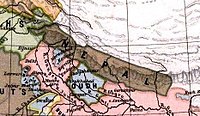The Gupta Empire was an ancient Indian empire on the Indian subcontinent which existed from the early 4th century CE to early 6th century CE. At its zenith, from approximately 319 to 467 CE, it covered much of the Indian subcontinent. This period has been considered as the Golden Age of India by historians, although this characterisation has been disputed by some other historians. The ruling dynasty of the empire was founded by Gupta and the most notable rulers of the dynasty were Chandragupta I, Samudragupta, Chandragupta II, Kumaragupta I and Skandagupta.

Chandragupta II, also known by his title Vikramaditya, as well as Chandragupta Vikramaditya, was the third ruler of the Gupta Empire in India. Modern scholars generally identify him with King Chandra of the Delhi iron pillar inscription.

Chandragupta I was a king of the Gupta Empire, who ruled in northern and central India. His title Mahārājadhirāja suggests that he was the first emperor of the dynasty. It is not certain how he turned his small ancestral kingdom into an empire, although a widely accepted theory among modern historians is that his marriage to the Licchavi princess Kumaradevi helped him extend his political power. Their son Samudragupta further expanded the Gupta empire.
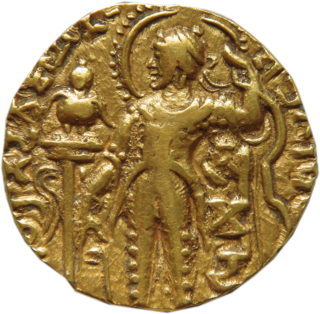
Samudragupta (Gupta script: Sa-mu-dra-gu-pta, was the second emperor of the Gupta Empire of ancient India, and is regarded among the greatest rulers of India. As a son of the Gupta emperor Chandragupta I and the Licchavi princess Kumaradevi, he greatly expanded his dynasty's political and military power.

Kumaragupta I was an emperor of the Gupta Empire of Ancient India. A son of the Gupta emperor Chandragupta II and Queen Dhruvadevi. He seems to have maintained control of his inherited territory, which extended from Gujarat in the west to Bengal region in the east.
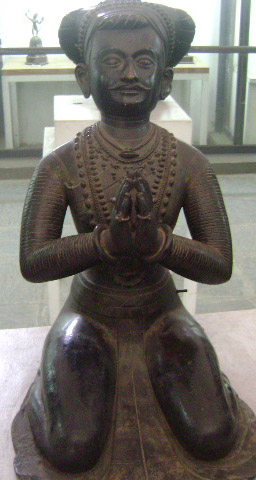
Amshuverma or Amshu Verma was a king of Nepal from around 605–621 CE. Initially a feudal lord, he rose to the position of Mahasamanta in about 598 CE when Shivadeva I of the Licchavi dynasty was the ruling monarch and by 604, Shivadeva was reduced to a mere figurehead. He is considered to have died in 621 AD and was succeeded by Udaydeva, the son of Shivadeva I.
Buddhism in Nepal started spreading since the reign of Ashoka through Indian and Tibetan missionaries. The Kiratas were the first people in Nepal who embraced Gautama Buddha’s teachings, followed by the Licchavis and Newar people. Shakyamuni Buddha was born in Lumbini in the Shakya Kingdom. Besides Shakyamuni Buddha, there are many Buddha(s) before him who are worshipped in different parts of Nepal. Lumbini lies in present-day Rupandehi District, Lumbini zone of Nepal. Buddhism is the second-largest religion in Nepal. According to 2001 census, 10.74% of Nepal's population practiced Buddhism, consisting mainly of Tibeto-Burman-speaking ethnicities and the Newar. However, in the 2011 census, Buddhists made up just 9% of the country's population.

Ghatotkacha was a pre-imperial Gupta king of northern India. He was a son of the dynasty's founder Gupta, and the father of the dynasty's first emperor Chandragupta I.

Maithils, also known as Maithili people, are an Indo-Aryan ethno-linguistic group from the Indian subcontinent, who speak the Maithili language as their native language. They inhabit the Mithila region, which comprises Northern and Eastern Bihar and Northeastern Jharkhand in India and some adjoining districts of Nepal constituting Madhesh Province in addition to some terai districts of Bagmati and Koshi Provinces.
The Malavas or Malwas were an ancient Indian tribe. Modern scholars identify them with the Mallian people (Malloi) who were settled in the Punjab region at the time of Alexander's invasion in the 4th century BCE. Later, the Malavas migrated southwards to present-day Rajasthan, and ultimately to Madhya Pradesh and Gujarat. Their power gradually declined as a result of defeats against the Western Satraps, the Gupta emperor Samudragupta, and the Chalukya emperor Pulakeshin II.
There are conflicting theories regarding the original homeland and ancestry of the Gupta dynasty that ruled northern India between 4th and 6th centuries. Modern historians variously theorize that it originated in present-day Uttar Pradesh or Bengal, based on epigraphic, numismatic and literary evidence. The social group (varna) of the dynasty is also a matter of debate, with scholars variously placing them in kshatriya Vaishya, Brahmana, or other categories.
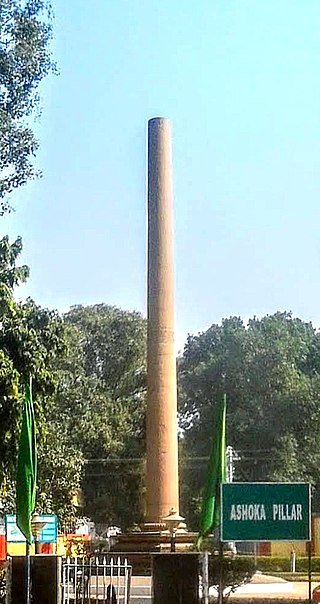
The Allahabad pillar is a stambha, containing one of the pillar edicts of Ashoka, erected by Ashoka, emperor of the Maurya dynasty, who reigned in the 3rd century BCE,. While it is one of the few extant pillars that carry Ashokan edicts, it is particularly notable for containing later inscriptions attributed to the Gupta emperor Samudragupta. Also engraved on the stone are inscriptions by the Mughal emperor Jahangir, from the 17th century.
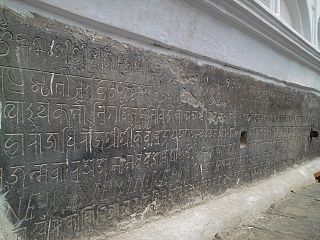
Stone inscriptions in the Kathmandu Valley refer to ancient stone slabs, pillars and pedestals with text carved on them. They are the most important sources for the history of Nepal. A vast majority of the inscriptions found in Nepal are from the Kathmandu Valley where they are an ubiquitous element at heritage sites. They consist of royal edicts and dedicatory notes on Hindu and Buddhist temples, stupas, statues, water spouts and other architectural structures. Stone inscriptions are locally referred as Lōhan Pau.

The Gupta era is a historical calendar era that begins from c. 318–319 CE. It was used by the Gupta emperors, as well as their vassals and their successors in present-day northern India and Nepal. It is identical to the Vallabhi era, which was used in the Saurashtra region of western India, although regional differences lead to a slightly different calculation for the conversion of Vallabhi era years to Common Era (CE).

Kacha was a king of India, possibly a member of the Gupta dynasty. He is known only from his gold coins, which are similar to those of the Gupta king Samudragupta.
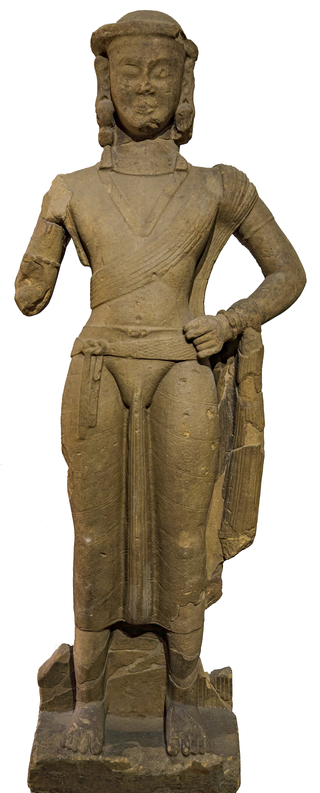
The Statue of Jayavarma is a sculpture of King Jayavarma.
The earliest inhabitants of modern Nepal and adjoining areas are believed to be Australoid people. By 4000 BCE, the Tibeto-Burmese people had reached Nepal either directly across the Himalayas from Tibet or via Myanmar and north-east India or both. By the late Vedic period, Nepal was being mentioned in various Hindu texts, such as the late Vedic Atharvaveda Pariśiṣṭa and in the post-Vedic Atharvashirsha Upanishad. The Gopal Bansa was the oldest dynasty to be mentioned in various texts as the earliest rulers of the central Himalayan kingdom known by the name 'Nepal'. The Gopalas were followed by Kiratas who ruled for over 16 centuries by some accounts. According to the Mahabharata, the then Kirata king went to take part in the Battle of Kurukshetra. In the south-eastern region, Janakpurdham was the capital of the prosperous kingdom of Videha or Mithila, that extended down to the Ganges, and home to King Janaka and his daughter, Sita.
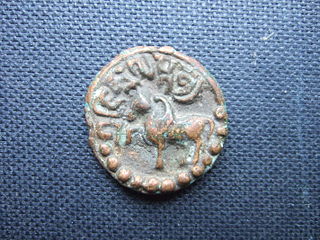
The Abhira-Gupta Dynasty also known as the Ahir-Gupta dynasty was a dynasty which existed in the Kathmandu Valley in modern-day Nepal. These Abhira-Guptas had overshadowed the Licchavi kings in the administration. Ravigupta, Bhaumagupta, Jishnugupta and Vishnugupta of Abhira-Gupta family controlled Kathmandu (Nepal) as de facto-ruler during many Lichchhavi kings.

Jishnu Gupta, often spelled Jishnugupta, was a de facto ruler of Nepal in the 7th-century during the time of the Lichchhavi dynasty. Initially sharing the administrative powers with Dhruvadeva from 624 CE, he became the highest authority in the realm from around 627. He belonged to the Abhira-Gupta dynasty.
Dhruvadeva, also spelled Dhruva Deva, was a son of Shivadeva I of the Licchavi dynasty and a king of Nepal in the 7th century. He deposed his brother Udaydeva with the help of Jishnu Gupta and reigned as a figurehead monarch.


 /
/ 
 Cha-ndra/gu-pta vertically.
Cha-ndra/gu-pta vertically.


 𑁊Li-ccha-va-yah.
𑁊Li-ccha-va-yah.



